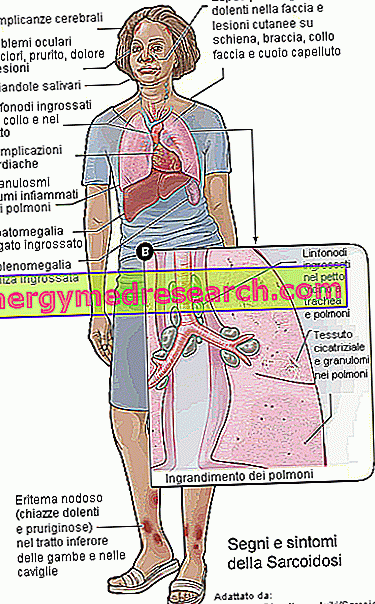Key points
Sarcoidosis is a chronic inflammatory disease that can involve all organs, especially the lungs, lymph nodes, eyes and skin. It is characterized by the formation of granulomas, inflamed cell masses that proliferate in the various anatomical districts.
Causes
The cause of sarcoidosis is still unknown; however, genetic predisposition is believed to play an important role in triggering the disease. Among the risk factors we cannot forget: exposure to beryllium / zirconium / aluminum, female sex, age> 50 years and infections.
Symptoms

Diagnosis
The diagnostic techniques used to ascertain sarcoidosis include: clinical observation, biopsy, bronchoscopy with broncho-alveolar lavage, radiological examination, assessment of respiratory capacity, blood tests, liver function tests.
Therapy
When necessary, it is possible to follow a drug therapy for the treatment of sarcoidosis: corticosteroids, NSAIDs, anti-rejection drugs, antimalarial drugs, drugs inhibiting alpha tissue necrosis factor.
Definition of sarcoidosis
Sarcoidosis is a chronic, multisystemic, purely inflammatory disorder. This disease can ideally involve all organs; however, the lungs, lymph nodes, eyes and skin appear to be the preferred targets. Sarcoidosis is characterized by the presence of particular nodulose masses called granulomas : these are small agglomerates of inflamed cells that propagate easily in different anatomical sites.
Although it has been described as far back as the 1800s, sarcoidosis still captures the attention of many researchers, since it is not possible to trace a concrete and well-defined cause. However, it is likely that genetic predisposition, together with some environmental factors, play a major role in triggering the disease.
Incidence and mortality
Sarcoidosis most commonly affects subjects between the ages of 20 and 40; a second incidence peak is observed in menopausal women over 50 years of age.
Between the two sexes, women seem slightly more involved. In fact, from the statistics reported in the American Family Physician magazine, it appears that sarcoidosis affects 16.5 men per 100, 000 healthy and 19 women per 100, 000 healthy.
Sarcoidosis is a relatively common condition:
- In the United States, there are on average 10-40 sarcoidosis patients per 100, 000 healthy inhabitants. In particular, the disease mainly affects the black race.
- In Denmark, there are 7-10 sarcoidosis patients per 100, 000 healthy inhabitants.
- In Sweden as many as 64 people per 100, 000 are affected by this disease: compared to all European countries, Sweden is home to the largest number of sarcoidosis patients.
We do not receive reliable data on the mortality generated by sarcoidosis; however, it appears that the mortality rate is between 5 and 10%.
Cardiac sarcoidosis (in which granulomas develop in the heart muscle) appears to be the most serious variant of the disease, which can be fatal: death occurs due to left heart failure. The end stage of pulmonary sarcoidosis can also induce death by respiratory failure.
Causes and risk factors
Despite the numerous etiological researches (on the causes), the triggering factor of sarcoidosis has not yet been identified with certainty. However, it appears that many patients are genetically predisposed to sarcoidosis: in these individuals, the disease appears to be triggered by bacterial or viral infections.
Hypothesis: infectious agents involved in sarcoidosis
- Bacteria → Chlamydia trachomatis, Propionibacterium acnes, Borrelia burgdorferi, Mycoplasmas, Mycobacterium Tuberculosis, Rickettsie
- Virus → Herpes virus, Epstein-Barr virus (EBV), Retrovirus
What is certain and indisputable, is that the inflamed cellular masses typical of sarcoidosis are due to the uncontrolled aggregation of some cells of the immune system.
RISK FACTORS
Although sarcoidosis does not recognize any precise cause, it is possible that some risk factors predispose a subject to the disease:
- Living in Scandinavian countries: there are numerous cases of sarcoidosis in these places. From what has been said, it is possible to hypothesize that the climate and humidity of these regions constitute risk factors for sarcoidosis.
- Repeated exposure to occupational beryllium, aluminum and zirconium may trigger clinically indistinguishable granulomatous diseases from sarcoidosis
- Female sex and age over 50 years
- Familiarity: the children of parents affected by sarcoidosis are 5 times more exposed to the disease than those born to a healthy mother and father.
Description of the granuloma
Granulomas are the characteristic signs of symptomatic sarcoidosis. These are relatively small inflamed cell clusters with intense proliferative activity.
Generally, granulomatous lesions unmistakably mark sarcoidosis. On laboratory examination, the granuloma is composed of a central area and a peripheral zone:
- Central zone → rich in macrophages (in different stages of activation and differentiation), Langerhans cells surrounded by CD4 (or T-helper) lymphocytes and epithelioid cells (of macrophage derivation), and giant cells with Schaumann bodies (cells with capacities) phosphatase)
- Peripheral zone → rich in CD8 lymphocytes (suppressors), antigen presenting cells (macrophages) and plasma cells
Although they can appear in any anatomical site, granulomas tend to originate in the lungs and, subsequently, to spread in areas: skin, central nervous system, eyes, kidneys, liver, spleen and lymph nodes.
Granulomas can be completely reabsorbed - therefore they disappear in a more or less long period of time (months / years) without causing permanent damage - or they can create irreparable injuries. In the latter case, sarcoidosis follows a chronic course: the granulomas are not able to reabsorb spontaneously, therefore the affected tissue is damaged. The damage developed is proportional to the spread of granulomas and depends on the district involved: clearly, when important organs such as the heart are affected, sarcoidosis is extremely dangerous and, if it is not promptly acted upon, the patient can also undergo death.
Let us remember, however, that sarcoidosis is fatal only in a small percentage of cases (5-10%).



